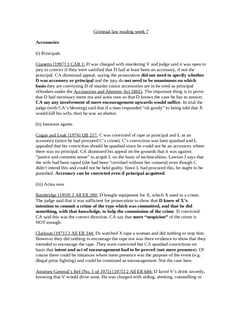R v Matthews and Alleyne [2003] Crim L R 553
Judgement for the case R v Matthews and Alleyne
ORIGINAL ANALYSIS
Matthews (M), Alleyne (A) and two others threw a boy off a bridge into a river after he told them that he couldn’t swim.
He drowned, and the judge directed that if the boy’s death was appreciated by the defendants as a virtual certainty then the jury should convict of murder.
-
They were convicted and the CA dismissed their appeal. The appeal was based on the way the judge presented the “virtual certainty” rule, which was as a rule of law, not of evidence, by differing from the accepted form of “you may not convict unless…”
However there was held to be no real difference between the “virtual certainty rule” as a rule of law and a rule of evidence and therefore the appeal fails.
ADDITIONAL ANALYSIS - KEY POINTS
This case analyzes intent, particularly in cases where the recognition of virtual certainty of death becomes a pivotal factor indicative of the intention to kill.
-
Central to the discourse on intent in murder cases is scrutinizing the Nedrick/Woollin direction. This legal framework is a pivotal reference point in determining intent within the complex landscape of criminal law.
A comprehensive analysis of the Nedrick/Woollin direction is essential to assess its significance in shaping the legal understanding of intent, particularly in cases involving potential harm or fatality.
Understanding the role of this direction contributes to a more informed perspective on how the legal system deals with issues of intent in serious criminal offenses.
-----
FACTS
The appellants faced convictions, including murder, stemming from an incident where the victim was thrown into a river from a bridge. The trial judge provided specific directions to the jury concerning the element of intent to kill. The instructions were outlined as follows:
-
The prosecution could establish intent to kill by proving either:
(i) Making the jury sure that the specific intention to kill was present in the mind(s) of the defendants, or
-
(ii) Making the jury sure that the deceased's death was a virtual certainty (excluding attempts to save him). This hinges on two conditions:
(a) The defendant, at the time of throwing the deceased off the bridge, appreciated that death was a virtual certainty and
(b) The defendant had no intention of saving the victim, knowing or realizing that others present also had no intention of saving him.
The appellants raised objections, asserting that this constituted a misdirection. They contended that the alternative (ii) was presented as a substantive rule of law rather than a rule of evidence. According to the appellants, this argument implies that the judge had incorrectly characterized the alternative as a legal principle rather than a guideline for the jury in evaluating the evidence related to intent.
JUDGEMENT
The appeals were dismissed. The court ruled that although deliberately acting with an appreciation of the virtual certainty of death didn't automatically imply intent to kill, it could be considered evidence of such intent.
If the jury believed the appellants knew the victim's death was virtually certain when thrown off the bridge and had no intention of saving him, it logically implied an intent to cause the victim's death.
The judgment highlighted the challenge in distinguishing between a rule of evidence and one of substantive law when the requirement was an appreciation of virtual certainty of death, not just probable consequences.
COMMENTARY
The Nedrick/Woollin cases were examined because of their importance in assessing intent in murder trials, particularly those involving probable damage or fatality.
The appeals were eventually denied, reaffirming that an appreciation of the virtual certainty of death does not necessarily prove intent to kill but can serve as evidence.
RELATED CASES
For Further Study on R v Matthews and Alleyne
Need instant answers? Our AI exam tutor is here to help.
Ask questions 🙋 Get answers 📔 It's simple 👁️👄👁️
Our AI is educated by the highest scoring students across all subjects and schools. Join hundreds of your peers today.
Get StartedRelated Product Samples
These product samples contain the same concepts we cover in this case.
| Criminal Law | Homicide Notes (20 pages) |
| Criminal Law | Mens Rea — Intention Recklessness And Negligence Notes (24 pages) |

 Since 2010, Oxbridge Notes has been a trusted education marketplace, supplying high-quality materials from top achievers at universities like Oxford, Cambridge, LSE, Harvard, and Yale.
Since 2010, Oxbridge Notes has been a trusted education marketplace, supplying high-quality materials from top achievers at universities like Oxford, Cambridge, LSE, Harvard, and Yale.